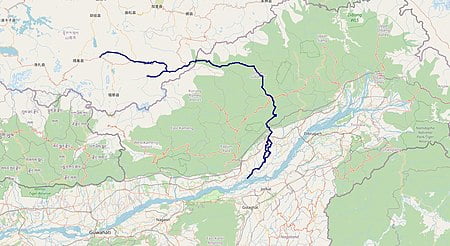Subansiri River

The Subansiri River (Chinese: 西巴霞曲; pinyin: xībā xiá qǔ) is a trans-Himalayan river and a tributary of the Brahmaputra River that flows through Tibet’s Lhünzê County, Shannan Prefecture and the Indian states of Arunachal Pradesh and Assam. The Subansiri is 442 kilometres (275 mi) long, with a drainage basin 32,640 square kilometres (12,600 sq mi).[1] It is the largest tributary of the Brahmaputra contributing 7.92% of the Brahmaputra’s total flow.[2]
The name is derived from a Sanskrit word ‘swarn’ meaning gold.[3]
Originally the name applied to the river only after the confluence of the Chayul Chu and Tsari Chu rivers at Gelensiniak.[3] In early maps of independent India, Tsari Chu was marked as the main Subansiri river. However, over time, the name has been transferred to Chayul Chu. Within Tibet, the rivers are named after the locations they flow from such as Loro Chu, Nye Chu, Char Chu and Chayul Chu, all of which apply to the Subansirir or its tributaries.
The Subansiri River originates in the Himalayas near Mount Porom in the Tibet Autonomous Region of China.[3]
It enters India near the town of Taksing and flows east and southeast through Miri Hills,[3] then south to the Assam Valley at Dulangmukh in Dhemaji district,[4] where it joins the Brahmaputra River at Jamurighat in Lakhimpur district. Small tributaries of the Subansiri include Rangandi, Dikrong and Kamala.[3]
The Subansiri lends its name to two districts in Arunachal Pradesh: Upper Subansiri and Lower Subansiri.
The observed discharge of Subansiri is a maximum of 18,799 cubic metres per second (663,900 cu ft/s), and minimum of 131 m3/s (4,600 cu ft/s). It contributes 7.92% of the Brahmaputra’s total flow.
